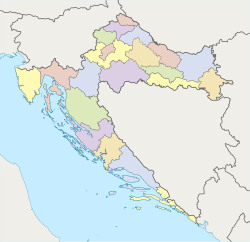
Postal codes in Croatia are 5 digit numeric. There are 20 two digit zones defined. Zagreb City and Zagreb County have one, each other first level administrative country subdivision, i.e. one of the counties of Croatia, has its own range. When sending internationally, it's advisable to prefix the postal code with the ISO 3166-1 alpha-2 code for Croatia [1] (for example: HR-10xxx [2] ).
Contents
From the 10 possible 1 digit ranges only 5 are assigned:
- 1 Zagreb region,
- 2 Southern Croatia,
- 3 Eastern Croatia,
- 4 Central Croatia except Zagreb region,
- 5 Western Croatia.
In the range 1xxxx only one two digit range namely 10xxx is assigned, the maximum of subranges exists is in the 4xxxx range with 7 ranges.
| Range | Location |
|---|---|
| 10xxx | City of Zagreb and Zagreb County |
| 20xxx | Dubrovnik-Neretva County |
| 21xxx | Split-Dalmatia County |
| 22xxx | Šibenik-Knin County |
| 23xxx | Zadar County |
| 31xxx | Osijek-Baranja County |
| 32xxx | Vukovar-Srijem County |
| 33xxx | Virovitica-Podravina County |
| 34xxx | Požega-Slavonia County |
| 35xxx | Brod-Posavina County |
| 40xxx | Međimurje County |
| 42xxx | Varaždin County |
| 43xxx | Bjelovar-Bilogora County |
| 44xxx | Sisak-Moslavina County |
| 47xxx | Karlovac County |
| 48xxx | Koprivnica-Križevci County |
| 49xxx | Krapina-Zagorje County |
| 51xxx | Primorje-Gorski Kotar County |
| 52xxx | Istria County |
| 53xxx | Lika-Senj County |

Three cities have a postal code with 4 zeros: 10000 Zagreb, 20000 Dubrovnik, 40000 Čakovec.
| Range | City | County |
|---|---|---|
| 10000 | Zagreb | Zagreb County |
| 20000 | Dubrovnik | Dubrovnik–Neretva County |
| 21000 | Split | Split-Dalmatia County |
| 22000 | Šibenik | Šibenik-Knin County |
| 23000 | Zadar | Zadar County |
| 31000 | Osijek | Osijek-Baranja County |
| 32000 | Vukovar | Vukovar-Syrmia County |
| 33000 | Virovitica | Virovitica–Podravina County |
| 34000 | Požega | Požega-Slavonia County |
| 35000 | Slavonski Brod | Brod–Posavina County |
| 40000 | Čakovec | Međimurje County |
| 42000 | Varaždin | Varaždin County |
| 43000 | Bjelovar | Bjelovar–Bilogora County |
| 44000 | Sisak | Sisak–Moslavina County |
| 47000 | Karlovac | Karlovac County |
| 48000 | Koprivnica | Koprivnica-Križevci County |
| 49000 | Krapina | Krapina-Zagorje County |
| 51000 | Rijeka | Primorje-Gorski Kotar County |
| 52000 | Pazin | Istria County |
| 53000 | Gospić | Lika-Senj County |